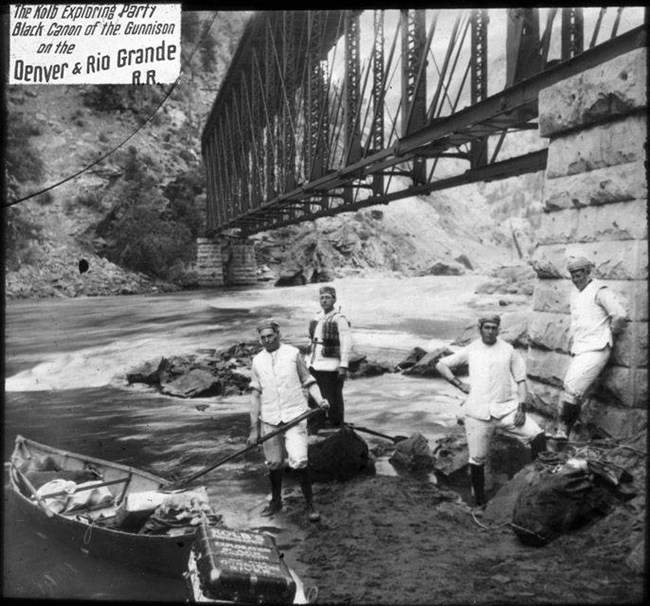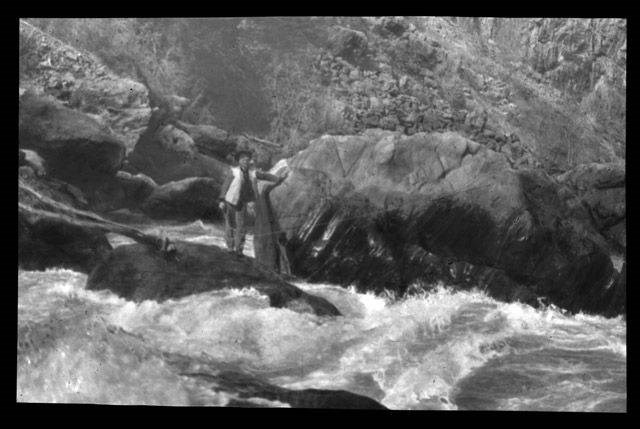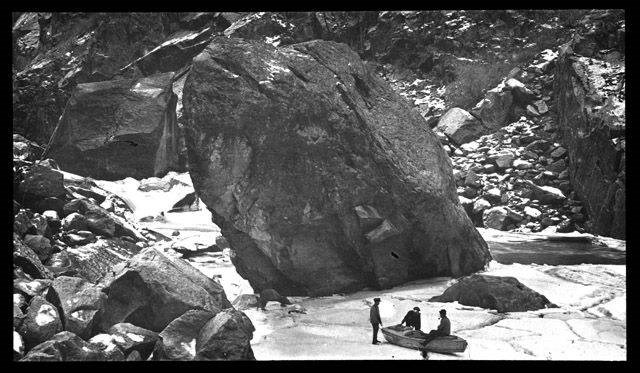Last updated: January 2, 2025
Article
Kolb Expedition - 1916

Emery Kolb Collection, NAU.PH.3722. Northern Arizona University. Cline Library Special Collections and Archives.
First Attempt
Kolb, along with two of his three partners for the trip, met up on the Lake Fork of the Gunnison River in July 1916. He oriented them to the photographic equipment, including a cinematograph, and to the canvas boats they would use on the river. After running the Lake Fork, they met Julius Stone at Cimarron. He was the financier for many of the Kolb's trips.
The biggest problem to overcome was the high-water level. The winter of 1915-16 was the start of a series of wet years, with abundant snow in the mountains of the river basin. The estimated river flow was 1,600 cubic feet per second, a very high rate for the Gunnison River. Intending to press ahead, they started off on July 25, 1916, after a rainstorm. A crowd from Cimarron came out to watch their departure from the railroad bridge. Kolb set out with cameras ready. Nearly out of sight of the crowd was a large "pinwheel" rapid, or a perpendicular whirlpool. Running the rapid like "a bronc at the end of a lasso," he stayed with it, until the river turned him over. Likewise for the second boat and a small life-raft they had brought along. Despite failing "to cover ourselves with glory," and "being out one boat, a life-raft, trunk, camp bed," and quite a bit of film, Kolb remained upbeat about the adventure.
They laid over a day at the Black Canyon Hotel in Cimarron due to heavy rains. They got away early and portaged around the rapid that had subdued them two days before. They successfully negotiated the river that day, but not the next. The rapids became heavy, and Kolb yearned for the heavy wooden boats that he used on the Colorado. It was difficult to cross the river at high flows. The current was too swift to swim, and the one small canvas boat made crossing slow and cumbersome. It began to rain and one of the trip members became ill with a high fever.They made their way downstream, working along the shoreline, until the remaining boat swamped. The slow pace, unsuitable boat, Stone's fever, and rotten weather led them to abandon the trip. They hiked out the next day, and folks from the Thompson Ranch drove them into town.

Emery Kolb Collection, NAU.PH.568.3752. Northern Arizona University. Cline Library Special Collections and Archives.
A Second Try
Kolb and one of his partners went back into the canyon on the East Portal Road, which leads to the Gunnison Tunnel, and worked his way upstream to get the boat and supplies. After fixing the boat he rode it down river, lining it around rapids when needed. After making it to the tunnel, he decided to wait for a lower stage of water and the wooden boats to be sent by Stone. In the meantime, he contacted river runner Bert Loper to join him down the Colorado River from the high country to Grand Junction in a wooden canoe. They also did a run through the Gunnison Tunnel, completing the 6-mile trip in 65 minutes.
Stone’s heavy wooden boats arrived in mid-October. They put in at East Portal with lower water levels and floated the first stretch without much trouble.The next day, when they were lining a boat through a tight channel, the bow shot into the air and the stern settled into the water. "We had overlooked the fact that most of the water ran under the rocks, and the boat was trying to make a short-cut." But the thing was jammed, wedged tight into the boulders. Kolb hiked back to East Portal and borrowed a hammer, drills and dynamite from Walter Tupper, a tunnel gate keeper. They went to work and drilled a three-foot hole. Loper, a former miner, set the charge with a half stick, but the blast merely shook the rock. Two more sticks finished the job. After repairing part of the boat and losing a few days, they carried on.
Continuing downstream at a half mile per day, they lined the boats through the difficult rapids to the Narrows. The rocks were "slippery as glass." While pulling on a rope, Loper slipped and struck his back on a protruding rock. In great pain, Kolb nursed him for two days having only a hot water bottle to ease the pain. That night a storm brought several inches of snow. Low on food, they lined one heavy boat through one last rapid. They couldn't get a good footing on the icy rocks and holding the craft proved too much for them. It tipped, and filled with water before they could get it secured. Kolb slipped on the large boulders, wrenching his knee. They devoured the rest of their food, scrambled to the canyon rim, and returned to Montrose.
News reports suggest that Kolb broke his kneecap. Loper had back pain and two broken ribs. A telegram from Loper’s wife had also arrived saying she was quite ill, so he quickly left for home.

Emery Kolb Collection, NAU.PH.568.3832. Northern Arizona University. Cline Library Special Collections and Archives.
Third and Fourth Attempt
After two weeks of warm days and rest, Kolb found a businessman, William Wright, from Montrose who had a week to spare. He joined him in the adventure. It was November and the weather could be unpredictable. They enjoyed a couple of nice days and moved the boat downstream to a precipitous 12-foot (3.7 m) waterfall to break for the day. That night a new storm brought more rain and snow, and the discouraged pair struggled to the canyon rim.
Kolb returned with a crew of three from Montrose, clambering into the canyon from the north rim on Thanksgiving Day. The party was determined to reach Red Rock Canyon, but the river was now mainly frozen over. In some cases, this enhanced their efforts. The work focused on carrying the cumbersome boat around and over the rocks that edged the shore.
The going became easier after rounding the bend below Chasm View, and Kolb ran a rapid in front of the Painted Wall. The top, bottom and sides of the boat separated near the stern, and all their provisions were lost. A final disaster struck when they were lining the patched craft through another rapid. The power of the river pulled the boat so that the entire strain was on one laborer. Unable to hold it longer, he let go. The boat crashed and sank.
Intending to hike out, they worked their way downstream until they had to cross the river. The water was swift and deep enough (up to their shoulders) that they could not cross. They retreated to shore and stayed despite the eight inches of snow that fell. The next day, the crew headed upstream and linked arm-in-arm to make the crossing in freezing waters. They limped up Red Rock Canyon and exited on December 8, 1916.
A Final Effort
Kolb stewed all winter about that last section of river, but he bided his time to get the best river running conditions in summer. He and 18-year-old Albert Moore of Montrose, put in at Red Rock Canyon in 1917 with a small canvas boat and supplies. Taking turns swimming and rowing down the river, they marveled at the beauty in Ute Park, and gloried in the rapids downstream from there. After pulling boats almost the entire way down the canyon, Kolb allowed the boat to tow him while he swam in the current.
Kolb dragged his boat out of the river at the Delta Bridge and finally completed his dream of exploring the Black Canyon in its entirety. To this day, only the most experienced kayakers attempt to traverse the Gunnison River through Black Canyon.
